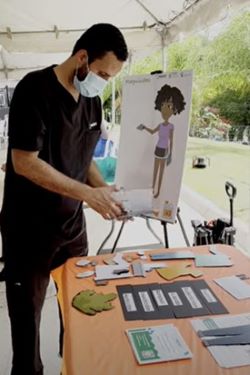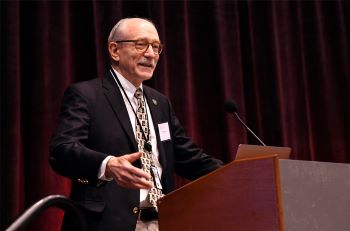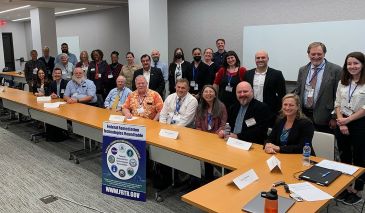Hot Off the Press
Research Briefs
New Model Estimates PFAS Exposures From Contaminated Drinking Water: Researchers partially funded by the NIEHS Superfund Research Program (SRP)developed a model to estimate individual exposure to four per- and polyfluoroalkyl substances (PFAS) commonly found in drinking water. The model integrates published data from multiple studies on PFAS levels in human blood along with measured PFAS concentrations in drinking water.
Combining Analytical Chemistry and Machine Learning to Detangle Mixtures: NIEHS Superfund Research Program (SRP)-funded researchers demonstrated a significant step toward identifying individual unknown chemical components in complex mixtures. Their approach uses advanced analytical techniques and sophisticated machine learning approaches while overcoming the time-consuming separation steps that precede traditional chemical analysis.
Dioxin Disrupts Liver Cells in Mice, Potential Link with Liver Disease: An SRP-funded study in mice reported that exposure to a type of dioxin can alter cells in the liver, their metabolic characteristics, and how they are organized within the liver. According to the researchers, these changes in cell behavior and organization play a role in the development of dioxin-induced liver diseases, such as fibrosis and fatty liver disease.
E-Factor Stories
Extramural Paper of the Month: Body weight and arsenic exposure interact to worsen type 2 diabetes indicators in mice: Researchers at the University of North Carolina at Chapel Hill (UNC) SRP Center uncovered complex interactions between exposure to arsenic, body weight and composition, and indicators of type 2 diabetes in Genetically Different Outbred Mice, which better captures the genetic variation of human populations.
Extramural Paper of the Month: Diet may protect against metabolic effects of PFOS: Dietary fiber may protect against metabolic and liver diseases related to perfluorooctane sulfonate (PFOS) exposure, according to SRP-funded researchers at the University of Kentucky.

Trainees translate research, display creativity in SRP video competition: Short, fun science videos produced by SRP trainees as part of a competition made their big-screen debut at the SRP Annual Meeting, held December 14-16 in Raleigh, North Carolina. SRP hosted the contest to encourage early-career researchers' science communication efforts.
Extramural Paper of the Month: Validating cell-based approaches for analyzing risk of exposure to industrial chemicals TCE and PCE: Cell-based experiments can provide relevant estimates of trichloroethylene and tetrachloroethylene metabolism in humans and associated health risks, found researchers at the Texas A&M University SRP Center.
Extramural Paper of the Month: Grouping wildfire exposures for improved health risk assessments: SRP-funded researchers at the University of North Carolina at Chapel Hill developed a computer-based approach to group wildfire exposure conditions based on their effect on genetic expression and potential health risks.

Celebrating 35 years of innovative Superfund research to promote health: SRP marked its 35th anniversary December 14-17, 2022, at its first in-person annual meeting since 2019. Researchers, trainees, and community partners from across the U.S. gathered in Raleigh, North Carolina, to learn about select SRP-funded projects through workshops and presentations.
Amanda Armijo wins 2022 Wetterhahn Award: Amanda Armijo, D.V.M., Ph.D., of the Massachusetts Institute of Technology SRP Center, was selected as the 25th recipient of the Karen Wetterhahn Memorial Award. Armijo received the award December 15 at the SRP Annual Meeting in Raleigh, North Carolina, where she was recognized for her work on tracing how the toxin N-Nitrosodimethylamine damages genes, and how the DNA might repair itself.
GenX Exposure Study reports results back to the community: North Carolina State University SRP Center researchers found high levels of six different per- and polyfluoroalkyl substances (PFAS) in blood of North Carolinians. They are working quickly to report findings back to the community and address their concerns.
Path to food safety requires multidisciplinary approach, experts say: Scientists who have SRP funding organized a workshop to discuss ways to reduce human exposure to toxic elements in food. Sponsored by the United States Department of Agriculture, the event focused on several themes: toxic element uptake and accumulation in plants; metal-soil interactions and cleanup; and food production and processing.

From research to innovation: technology transfer focus of roundtable: Strategies to move environmental cleanup technologies from research and development to the field headlined the agenda of the first in-person Federal Remediation Technologies Roundtable meeting in three years. The event brought together leaders from 10 federal agencies, including NIEHS, to discuss how they can collaborate to meet hazardous waste contamination cleanup goals and emerging needs.
Extramural Papers of the Month: Bacteria that degrade PCBs in sediment can reduce chemical emissions to surrounding air: Adding bacteria that can break down polychlorinated biphenyls (PCBs) to contaminated sediments reduced the release of the chemicals into surrounding air, according to University of Iowa SRP researchers. PCBs are a family of more than 200 structurally similar chemicals that have been linked to a range of adverse health effects, including some cancers.
2022 Papers of the Year: Tropical cyclones linked to rise in U.S. deaths: Over the last three decades, tropical cyclones in the U.S. were associated with higher death rates in subsequent months, according to an NIEHS-funded study.
2022 Papers of the Year: Silicone wristbands highlight chemical exposures following Hurricane Harvey: An Oregon State University SRP study was the first to reveal higher personal chemical exposures immediately following Hurricane Harvey.
2022 Papers of the Year: Pine needles work as passive samplers for PFAS: SRP-funded researchers showed that pine needles can be used as a tool to monitor the presence and distribution of PFAS over time.
Hot Pubs
Check out our new Hot Publications page to see brief summaries of papers that have been featured as the hot publication in the monthly e-Posted Notes newsletter!
to Top



